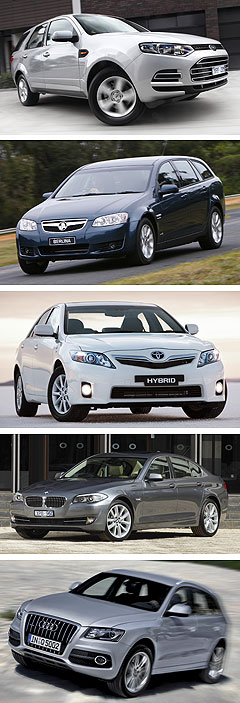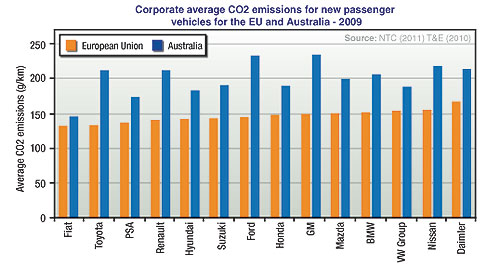News - Market Insight - Market Insight 2011Market Insight: Oz brand-for-brand CO2 higher than EUGreen with envy: The National Transport Commission attributes Australia’s relatively high CO2 emissions compared with the EU to our low petrol prices and consumer preference for less efficient cars. 2009 average passenger vehicle CO2 emissions in Australia 44 per cent higher than EU9 Sep 2011 A COMPARISON of 14 major vehicle manufacturers represented in the Australian and European Union markets reveals every one to have significantly higher corporate average CO2 emissions for passenger vehicles in Australia than in the EU. According to figures from the National Transport Commission (NTC) being considered in the federal government’s plans to impose mandatory CO2 targets on vehicle manufacturers, the average CO2 emissions of Australia’s new passenger car fleet in 2009 was 44 per cent higher than in the EU. The difference in CO2 figures between manufacturers in Australia is also significantly less consistent than in the EU, with averages ranging from 145 grams per kilometre (Fiat) to 234g/km (GM/Holden) – a variance of 89g/km, compared with the EU’s spread of just 36g/km. Understandably Ford and General Motors have the greatest discrepancy between Australia and the EU due to their unique six- and eight-cylinder large car (and in Ford’s case, related SUV) offerings in the Australian market. GM got the wooden spoon for highest passenger car CO2 emissions in 2009, its fleet emitting an average of 234g/km, closely followed by Ford with 232g/km. Their European counterparts’ emissions were 147g/km for GM and 144g/km for Ford in 2009, meaning their respective Australian averages were 58 per cent and 61 per cent higher.  From top: Ford Territory, Holden Commodore Sportwagon, Toyota Camry hybrid, BMW 5 Series, Audi Q5. From top: Ford Territory, Holden Commodore Sportwagon, Toyota Camry hybrid, BMW 5 Series, Audi Q5.Toyota’s Australian average of 211g/km was 60 per cent higher than in the EU, where it is a close second to Fiat with an average of just 132g/km. The NTC attributes Australia’s comparatively poor performance to differences in fuel prices and consumer preferences. Sales figures show Australia to be experiencing an SUV boom but other factors could be at play, for instance some manufacturers taking advantage of less stringent emissions standards in countries like Australia. For example, it is not uncommon for manufacturers to continue exporting cars with more polluting but cheaper engines where they can get away with it while only selling Euro 5-compliant or low-CO2 vehicles in markets that mandate them. In addition, the most efficient variants of some vehicles are unavailable in Australia, although this could be linked to consumer preferences as Australians tend to prefer more powerful vehicles with automatic transmissions. This is in contrast to many Europeans who are happy to wring every ounce of performance out of a small engine with the use of a manual gearbox – which could be linked to a combination of decades of economic conditioning, higher population density and the greater number of narrow, winding roads. Some car companies operating in Australia have said that this market is unsuitable for particular low-emissions technologies, given our hot summer temperatures, while up until recently the sulphur content in the diesel fuel was used as a factor in preventing certain engine variants from sale here. Diesel vehicles are only just gaining traction in the Australian market, with just 15 per cent of passenger cars being diesel powered, compared with the 50 per cent uptake across Europe (70 per cent in Belgium, France and Spain). However, German luxury brands BMW and Audi both report that at least half of their Australian sales volume is now for diesel-powered cars. A 2.7 per cent decrease in CO2 emissions in 2010 was exceeded by Australian-built vehicles made by Ford, Holden and Toyota, who achieved a combined reduction of 4.7 per cent over the previous year to 247g/km, although this was still 16.2 per cent higher than the 212.6g/km national average. Performance by the locals is likely to drop further now that Holden is building the small-segment Cruze in South Australia and has recently announced improvements to the Commodore’s fuel economy, while Ford has introduced a diesel Territory, the EcoLPi Falcon and is preparing a four-cylinder EcoBoost Falcon. In 2010 the only Australian-made vehicles that fell below the national average for CO2 emissions were the four-cylinder Toyota Camry (208g/km) and Camry Hybrid (142g/km), which – along with the related Aurion six-cylinder – are also due for replacement by more efficient models. The NTC lists seven European measures it sees as having reduced CO2 emissions, including high fuel prices, tax advantages for diesel, mandatory targets for manufacturers and variable registration fees based on CO2 output. It also cites government cash incentives to purchasers of low-CO2 vehicles, information stickers on vehicles in dealerships (like those on electrical goods) and the inclusion of efficiency information in vehicle advertising. The Australian government offers few incentives for low-emissions vehicles, with no rebate on EVs and subsidies for purchasing (or converting to) LPG vehicles on the way to being phased out coupled with impending taxation increases on that fuel. As GoAuto has reported, the federal government has published a discussion paper outlining the issues involved in setting mandatory standards to reduce carbon dioxide emissions from new passenger cars, SUVs and light commercial vehiclesWithout government intervention, Australia’s annual rate of light vehicle CO2 reduction averaged 2.1 per cent between 2003 and 2010, but must continue at a higher rate of at least 2.25 per cent if the 2024 target of 155g/km is to be achieved – and only if 190g/km is achieved as a starting point in 2015. However, the Federal Chamber of Automotive Industries anticipates that without mandatory limits, market forces alone would result in a 1.8 per cent annual reduction between 2008 and 2020 – suggesting that intervention is necessary if targets are to be met.  Read more7th of September 2011  Federal government gets serious on CO2 targetsInterested parties invited to join the debate on mandatory CO2 emissions standards22nd of February 2011  Australian CO2 tailpipe emissions fallNational CO2 average falls 2.7 per cent in 2010 as new mandatory targets draw near21st of February 2011  Luxury car buyers switch to diesel powerBMW, Audi reach record diesel sales in 2010 |
Click to shareMarket Insight articlesResearch Market Insight Motor industry news |














Facebook Twitter Instagram